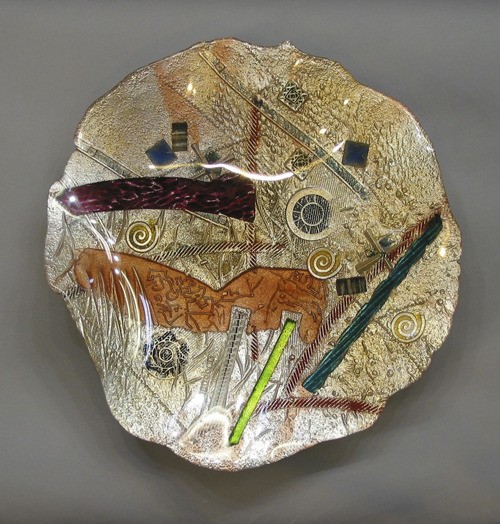By Stephen E. Adams
Keeping up with kiln-cast glass artist, Gerry Newcomb, becomes almost slapstick, running after him, notebook and recorder in hand, trying to catch (and eventually impart to the reader) just a fraction of his enthusiasm. Part of this requires digging through his self-deprecating comments, repeated so often they thread themselves into themes running through his commentary.
“If people only knew how much fun I was having, they wouldn’t pay me,” is one oft-repeated phrase. The part-time Lopezian—currently he is leading the interviewer on a chase through his south-end studio—also likes to point out after commenting on specifics of his work that he is “shallow, two dimensional, and narrow-minded, so what do I know?”
For anyone who’s experienced Newcomb’s work, however, the description “shallow, two dimensional, and narrow-minded,” wouldn’t come to mind. His pieces are, however, a great deal of fun to look at.
“For me, it’s a huge matter of perspective,” Newcomb offers, explaining how he considers his work from up-close, then a few feet back, then “how it’s going to strike you when you’re across the room.”
“Part of what’s so much fun is the fact that glass traditionally has to be viewed with light behind it to fully experience it. If you look at one of the fish at Chimera right now, the gold texture in the background presents a mirror image so you can light it any way you want.”
“One of the things people are always asking me is ‘What is the right side?’ and when I say, ‘It doesn’t matter,’ it takes a while for that to sink in.”
Having had “an entire career in clay” before ever beginning glass, Newcomb explains how he had to create his own process in order to come up with a way that would allow him to combine the “textures of clay” with the permanence of a cast glass piece. He even went so far as to come up with his own formula for the material used in constructing the mold which holds his piece.
Of the mold material he “invented,” he says, almost disparagingly, “It’s not rocket science. It’s just easier to have the company pre-blend it and that way, when I’m teaching a workshop, I can just tell them exactly what to order for the students to use.”
When asked about the molds, which can only be used one time, Newcomb shrugs his shoulders, explaining that, were he to reuse the mold, important detail would be lost. “Your whole pattern is mitigated a little bit with each recasting. Besides, who wants to do the same thing over and over?”
Asked about the distinctiveness of his style, one which, even in very different types of work, is strikingly evident, he replies that “…sometimes I wonder if there is a stylistic continuity to my work. It’s only later, when I look back at it that I’ll think, ‘Yeah, maybe there is a common element leaking through.’”
Participating in the Lopez Studio Tour this year allowed Newcomb to collect two years’ worth of “seconds, faux pas, and ‘the artist doesn’t have any sensibility’ pieces,” which permitted him to see his work together at one time.
“I usually make it, ship it off, and never see it again, so there was a sense of something—maybe ‘unified’ is the right word—happening here.”
A native Pacific Northwesterner, Newcomb cites his chief influence as being the Asian art that is so pervasive in the Pacific Rim area. He specifically mentions the sculptor and artist, George Tsutakawa, whose work is featured so prominently in cities such as Seattle, Tsutakawa’s home town, and the artist, Harold Balazs, with influencing the direction of his vision.
A variety of Newcomb’s work can be viewed at his website (http://www.gerrynewcomb.com/index.html) or at Chimera, where he is one of the featured artists in a show running through November 11. The site also has a fine description of the process by which a work is created.
Newcomb can be contacted through his website.




